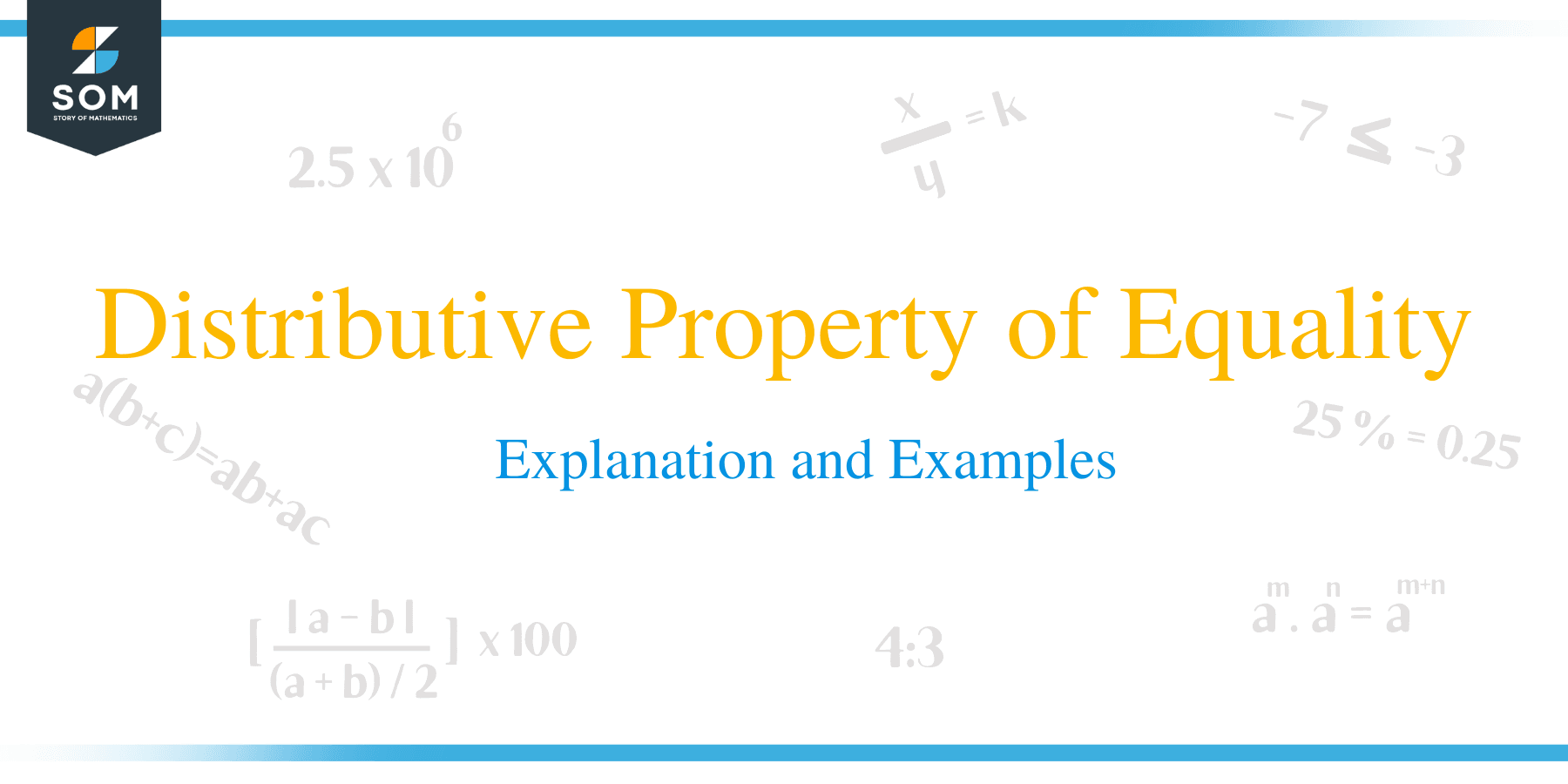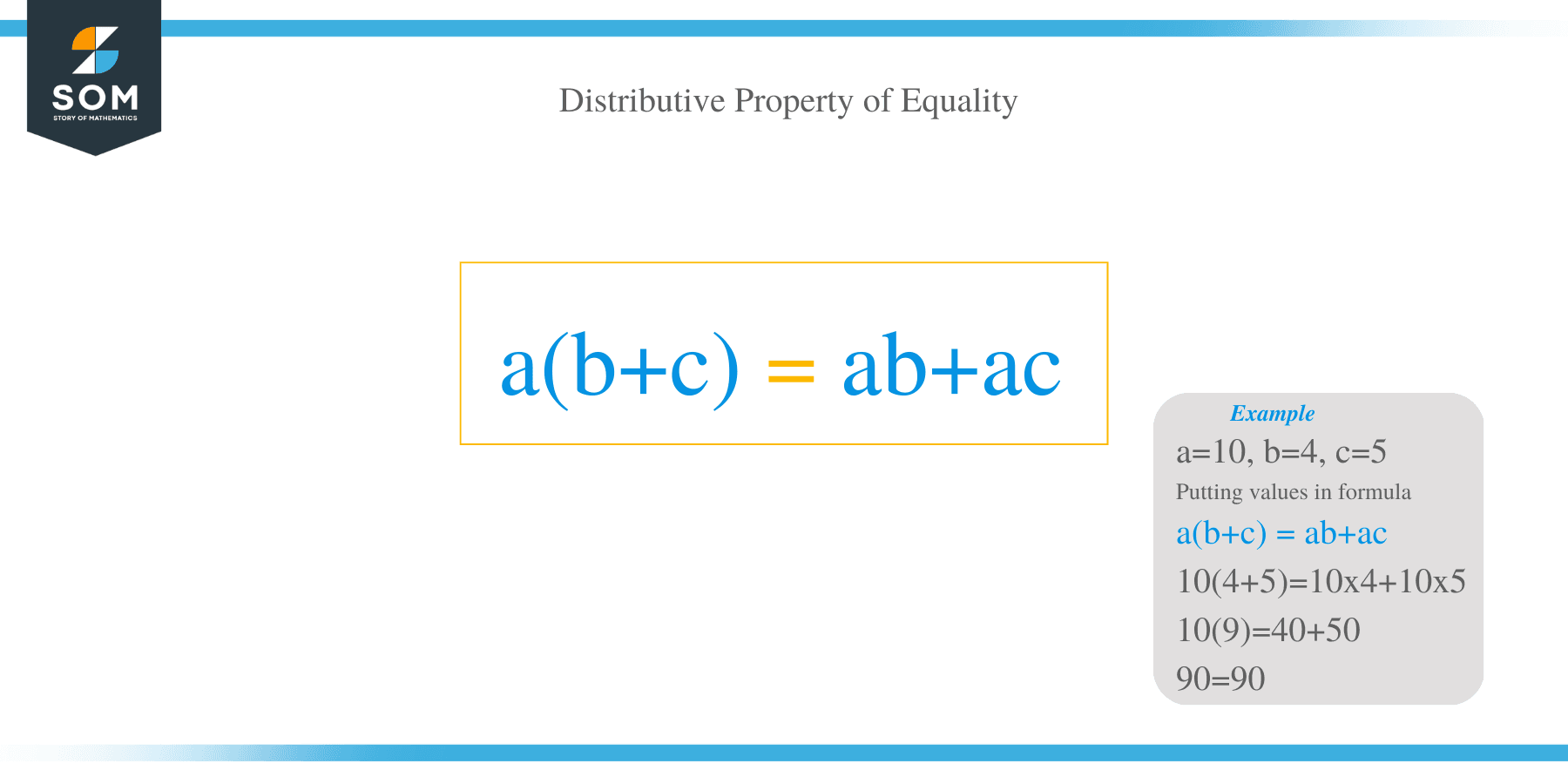- Home
- >
- Distributive Property of Equality – Explanation and Examples
JUMP TO TOPIC
The Distributive Property of Equality – Explanation and Examples
 The distributive property of equality states that equality holds even after distribution.
The distributive property of equality states that equality holds even after distribution.
This property is important for many arithmetic and algebraic proofs. It also explains mathematical operations.
Before moving on with this section, make sure that you have reviewed the general properties of equality.
This section covers:
- What Is Distributive Property of Equality
- Distributive Property of Equality Definition
- Converse of the Distributive Property of Equality
- Reverse Distribution
- Example of Distributive Property of Equality
What Is Distributive Property of Equality
The distributive property of equality states that equality holds after distribution.
Distribution in mathematics means multiplying one element by two or more added elements in parenthesis.
In particular, the distributive property of equality explains how multiplication and addition work in a situation such as $a(b+c)$ for real numbers $a, b,$ and $c$.
This has applications in arithmetic, algebra, and logic. It also paves the way for the algorithm to simplify the multiplication of binomials. This algorithm, or method, is often called FOIL.
Do not confuse this with a probability distribution. That is a separate concept that helps to explain likelihood of certain events.
Distributive Property of Equality Definition
Multiplying a quantity by the sum of two terms is the same as adding together the products of the original quantity and each term.
The distributive property can be generalized further. That is, multiplying a quantity by the sum of two or more terms is the same as adding together the products of the original quantity and each term.
A simpler way of saying this is that equality holds after distribution of terms.
In arithmetic terms, let $a, b,$ and $c$ be real numbers. Then:
$a(b+c)=ab+ac$.
The more general formulation is, let $n$ be a natural number and let $a, b_1,…, b_n$ be real numbers. Then:
$a(b_1+…+b_n)=ab_1+…+ab_n$

Converse of the Distributive Property of Equality
Since this property of equality does not rely on any terms being equal, there is not a real converse. The only formulation would be that, if distribution does not preserve equality, then the terms are not real numbers.
Reverse Distribution
The reverse operation of distribution is called factoring. Factoring takes a sum of two products and makes it into one element multiplied by the sum of two other terms.
Like distribution, factoring also works on more than two terms.
The distributive property of equality can be thought of as the factoring property of equality. This is by the symmetric property of equality.
That is, if $a, b,$ and $c$ are real numbers, then:
$ac+ab=a(c+b)$
Example of Distributive Property of Equality
A well-known proof that uses the distributive property of equality is the proof that the sum of natural numbers $1$ through $n$ is $\frac{n(n+1)}{2}$.
This proof relies on induction. Induction is a process where a statement is proved true for a specific natural number, usually $1$ or $2$. Then, the statement is assumed true for $n$. Induction shows that if the statement is assumed true, it follows it is true for $n+1$. Since all natural numbers are related to others by adding $1$, induction shows a statement is true for all natural numbers.
In this case, first prove the statement is true when $n=1$. Then, by substitution:
$\frac{n(n+1)}{2}=\frac{1(1+1)}{2}$
Through distribution, this is:
$\frac{1+1}{2}$
Simplifying yields:
$\frac{2}{2}$
$1$
Therefore, when $n=1$, the sum is $1$. This is true because, by reflexivity, 1=1.
Now, assume $\frac{n(n+1)}{2}$ is true for $n$. It is required to prove it is true for $n+1$.
If $\frac{n(n+1)}{2}$ is the sum from $1$ to $n$, then the sum from $1$ to $n+1$ is $\frac{n(n+1)}{2}+n+1$. Distribution simplifies this to:
$\frac{(n^2+n)}{2}+(n+1)$
Multiply $(n+1)$ by $\frac{2}{2}$ so that it can be added to $\frac{(n^2+n)}{2}$.
$\frac{(n^2+n)}{2}+\frac{2(n+1)}{2}$
Distribution yields:
$\frac{(n^2+n)}{2}+\frac{(2n+2)}{2}$
Adding the numerators gives:
$\frac{n^2+n+2n+2}{2}$
Which simplifies to:
$\frac{n^2+3n+2}{2}$
Now, substitute $n+1$ for $n$ in the expression $\frac{n(n+1)}{2}$. This is:
$\frac{(n+1)(n+2)}{2}$
The FOIL method, proved in example 3 below, reveals that this is equal to:
$\frac{n^2+3n+2}{2}$
This is equal to the sum of natural numbers from $1$ to $n+1$. That is, the formula holds for $n+1$. Thus, it is true for any natural number, $n$.
Examples
This section covers common examples of problems involving the distributive property of equality and their step-by-step solutions.
Example 1
Let $a, b, c,$ and $d$ be real numbers. Which of the following are true?
A. $(b+c)a=ba+ca$
B. $a(b+c+d)=ab+ac+ad$
C. $a(b+c)+b(d-a)=ac+bd$
Solution
All three statements are true. This is because of the distributive property of equality.
In the first case, commutativity states that $(b+c)a=a(b+c)$. Therefore, distribution still holds. Thus, $(b+c)a=ba+ca$. Again, by commutativity, $ba+ca=ab+ac$. Then $(b+c)a=ab+ac$.
B is also true. This is an application of the extended distributive property of equality. Distributing $a$ to each of the terms $b$, $c$, and $d$ gives $ab+ac+ad$.
The last one is trickier because it requires simplifying. Distributing gives $ab+ac+bd-ba$. But, rearranging the terms gives $ab-ba+ac+bd$. Since $ab-ab=0$, this is $ac+bd$. Therefore, $a(b+c)+b(d-a)=ac+bd$ is true.
Note that the third example included both addition and subtraction. Since subtraction is the same as adding a negative, distribution still holds when the terms in parenthesis are subtracted.
Example 2
Frank has an eat-in kitchen. Half of the kitchen has tile floor, and the other half has carpet. The whole room is one large rectangle.
Frank tries to figure out how large the room is. First, he measures the width of the room as $12$ feet. Then, he measures the length of the tiled section as $14$ feet and the length of the carpeted section as $10$ feet. He multiplies $12\times14+12\times10$ to get $288$ square feet.
Frank’s daughter also measures the area of the kitchen. She just measures the width of the room as $12$ feet and the length as $24$ feet. She multiplies to conclude that the area is $12\times24$ feet. That simplifies to $288$ square feet.
Why did Frank and his daughter come up with the same area despite using two different methods? Which property of equality explains this?
Solution
Let $w$ be the width of the room. Let $t$ be the length of the tiled section and $c$ the length of the carpeted section. $t+c=l$, the length of the room.
Then Frank found the area of the room by finding the area of the tiled section and the area of the carpeted section. He added them together to find the total area. That is, $wt+wc=A$, where $A$ is the total area.
His daughter, however, just found the length of the room and the width of the room. Her calculations were $w(t+c)=A$.
Frank and his daughter both found the same area because of the distributive property of equality. That is, it doesn’t matter if they multiply the width by the sum of the two lengths or add together the product of the width with each length. Either way, the room has $288$ square feet.
Example 3
The method for multiplying together two binomials is called FOIL. It stands for “first, inner, outer, last.”
Let $a, b, c,$ and $d$ be real numbers. Then $(a+b)(c+d)=ac+ad+bc+bd$ by FOIL.
Prove that this is true using the distribution property of equality.
Solution
Begin by thinking of $(a+b)$ as one term. Then the distribution property states that:
$(a+b)(c+d)=(a+b)c+(a+b)d$
Then, commutativity says this is equal to:
$c(a+b)+d(a+b)$
Using distribution again yields:
$ca+cb+da+db$
Rearranging the terms gives:
$ac+ad+bc+bd$
That is, by the distributive property of equality, $(a+b)(c+d)=ac+ad+bc+bd$.
Example 4
Use the distributive property of equality to verify that the following three expressions are equal.
- $4(1+2+9)$
- $4(3+3+3+3)$
- $4(16-4)$
Solution
Note that the terms in parentheses add up to $12$ in each of the three expressions. Therefore, each expression simplifies to $4(12) = 4\times12 = 48$.
Distributing should also give the same result.
In the first case, $4(1+2+9) = 4\times1+4\times2+4\times9=4+8+36=48$.
In the second case, $4(3+3+3+3) = 4\times3+4\times3+4\times3+4\times3 = 12+12+12+12=48$.
Finally, $4(16-4) = 4\times16-4\times4 = 64-16=48$.
Thus, all three simplify to $48$.
Example 5
Let $a, b, c, d,$ and $x$ be real numbers such that $a=b$ and $c=d$. Let $x(a-c)+x(d-b)+x=0$.
Simplify the expression. Then, solve for $x$.
Solution
First, distribute.
$x(a-c)+x(d-b)+x=xa-xc+xd-xb+x$
Since multiplication is commutative, this is:
$ax-cx+dx-bx+x$
Since $a=b$ and $c=d$, the substitution property says this is equal to:
$ax-bx+x$
This further simplifies to:
$x$
Therefore, the left side of the equation is $x$ and the right side is $0$. Thus, $x=0$.
